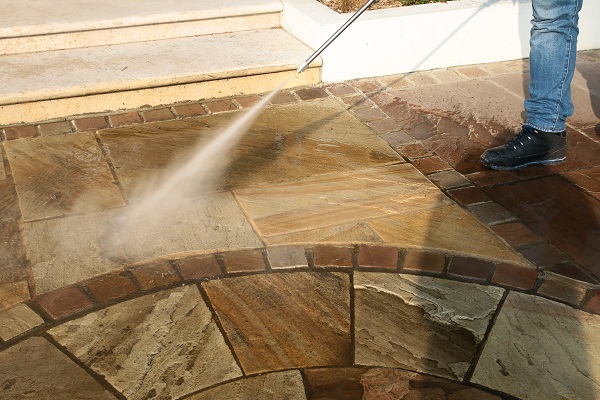
Brick pathways and patios add timeless charm to any outdoor space, but over time, they lose their beauty beneath layers of dirt, moss, weeds, and weather damage. Left untreated, these surfaces not only become unsightly but also dangerously slippery.
Enter pressure washing — a powerful way to restore brick to its former glory and extend the life of your hardscapes. 🧼✨
🧱 What Happens to Brick Over Time?
Brick is porous and constantly exposed to the elements, which makes it prone to:
- Moss and algae growth in shaded or damp areas
- Dirt and debris accumulation from foot traffic and wind
- Weeds growing between joints in pavers or bricks
- Mildew and mold, especially in humid climates
- Staining from leaves, rust, or fertilizer runoff
- Efflorescence, the white chalky residue from salts within the brick
All of this leads to surfaces looking aged, patchy, and unsafe.
💦 How Pressure Washing Revives Brick
Pressure washing cleans deep into the pores of brick and the joints between them. It removes layers of buildup that other tools can’t reach — and does it without damaging the material when done properly.
Here’s what power washing can accomplish:
✅ Strips away moss, mold, and algae
✅ Eliminates slippery surfaces
✅ Removes deep-seated stains
✅ Flushes out weeds and dirt between joints
✅ Restores color and texture
✅ Prepares surface for sealing or re-sanding
It’s like giving your patio or pathway a brand-new lease on life. 🌿🚿
🛠️ What You’ll Need to Pressure Wash Brick
To clean brick properly, you need:
- A pressure washer rated between 1,500 and 3,000 PSI
- A 25° or 40° nozzle tip (wide-angle to prevent damage)
- Brick-safe detergent or degreaser
- A stiff-bristle broom or brush for pre-treatment
- Optional: surface cleaner attachment for patios
Avoid turbo or zero-degree nozzles — they can chip or etch brick.
Browse Amazon Here For Top Rated Power Washers And Accessories
📋 Step-by-Step: Restoring Brick with a Pressure Washer
1. Clear the Area
Remove furniture, planters, and debris. Sweep the surface thoroughly.
2. Apply Detergent
Use a brick-safe cleaner and let it sit for 5–10 minutes to loosen buildup.
3. Scrub Trouble Spots
Agitate with a stiff brush if needed — especially where moss or mildew is thick.
4. Pressure Wash
Use even strokes and a wide nozzle. Stay 8–12 inches from the surface.
5. Rinse Thoroughly
Rinse away all soap and grime. Don’t leave detergent to dry on the surface.
6. Let It Dry
Allow at least 24 hours for full drying, especially if sealing afterward.
⚠️ Don’t Make These Common Mistakes
🚫 Using too much pressure – brick can chip or the mortar can crumble
🚫 Holding the nozzle too close – always maintain a safe distance
🚫 Skipping detergent – water alone won’t kill mold or remove deep stains
🚫 Forgetting to rinse – leftover cleaner may leave streaks or attract dirt
🚫 Not sealing afterward – unsealed brick will absorb moisture again quickly
Proper technique means a longer-lasting clean and less risk of damage. 🧱🧼
🌿 Weed Control and Joint Restoration
Power washing flushes out weeds and debris from between bricks. But afterward, you may need to:
- Re-sand the joints (for paver patios) with polymeric sand
- Apply a weed-prevention treatment
- Seal the surface to block moisture and stop regrowth
This final step is what keeps your brick patio looking clean for months or even years.
🧪 What About Stains?
Pressure washing can remove most common stains, especially when paired with the right cleaner:
| Stain Type | Recommended Treatment |
|---|---|
| Moss & algae | Algaecide cleaner + medium pressure rinse |
| Rust stains | Concrete/brick rust remover, let dwell, then rinse |
| Leaf stains | Mild bleach-based cleaner + agitation |
| Oil/grease | Degreaser, hot water pressure washer if possible |
| Efflorescence | Acid-based cleaner (caution: use with proper PPE) |
Always test a small area first before applying harsh cleaners.
🧼 Maintenance Tips for Clean Brick
To keep your brick patio or walkway clean long after pressure washing:
✅ Sweep weekly to prevent debris buildup
✅ Trim nearby trees/shrubs to reduce shade and moisture
✅ Seal the surface every 2–3 years
✅ Reapply joint sand when needed
✅ Wash lightly every 6–12 months to prevent buildup
Routine upkeep prevents the need for frequent deep cleans. 🌞
💼 Should You Hire a Pro?
For large patios or historical brick, hiring a pro is a smart move.
👷 Professionals Offer:
- Eco-safe cleaning agents
- Hot water systems for stubborn stains
- Vacuum recovery to prevent runoff
- Re-sanding and sealing services
- Expertise in preserving antique brick
A professional job saves time, minimizes risk, and delivers long-lasting results.
✅ Final Thoughts
Brick is beautiful, durable, and classic — but it needs a little help to stay that way. Power washing breathes new life into worn and stained patios and pathways, bringing back their rich color and clean texture.
When done properly, it doesn’t just clean — it protects your investment and restores your outdoor space to its original charm. 🧱✨💧
Browse Amazon Here For Top Rated Power Washers And Accessories



